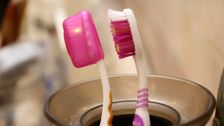There are lots of helpful travel gadgets on the market, ranging from high-tech tracking devices to simple products like a toothbrush cover.
But even though toothbrush covers are a popular staple ― both while you’re on a trip and even at home ― you might want to reconsider using one extensively. Below, dentists break down everything you should know.
What’s the problem with toothbrush covers?
“Covering a toothbrush with a toothbrush cover is a bad idea because the toothbrush cover traps moisture around the bristles, which is perfect for the proliferation of bacteria and fungus,” Dr. Jordan Brown, a dentist based in St. Petersburg, Florida, told HuffPost.
The oral cavity is covered with hundreds of species of bacteria like Streptococcus mutans and Granulicatella adiacens.
“When you brush your teeth, some of those bacteria are present on your toothbrush, even after properly rinsing it off with water,” said Dr. Aierress Davis, a dentist in Augusta, Georgia. “By placing your toothbrush in a cover and creating a moist environment, you directly promote bacterial growth, which isn’t a good thing.”
This proliferation of germs is especially likely if you place your toothbrush in the container while the bristles are still wet.
“Now, there isn’t much research that shows bacteria growing on a covered toothbrush causing harm to patients, but it is always better to allow your toothbrush to air dry after use,” Davis noted.
And although the potential for serious harm hasn’t been thoroughly researched, using a toothbrush cover can have some negative impacts.
“If you continue to use that same brush, it can lead to an increased risk of halitosis (bad breath), tooth decay (cavities), and abscesses (mouth infections),” Brown said.
So should you toss your toothbrush cover?
“There’s no need to use toothbrush covers for daily use inside the home,” Brown said. “If you’re worried about feces particulates from your flushing toilet you can either close the lid or move your toothbrush as far away from the toilet as possible.”
Indeed, the American Dental Association advises patients not to “routinely cover or store toothbrushes in closed containers,” and the dentists who spoke to HuffPost echoed this advice.
“I tend to not recommend toothbrush covers unless you can really make sure the bristles of the toothbrush are completely dry before placing the toothbrush in the container,” said Dr. Richard Lipari, a dentist who practices in Chappaqua, New York.
While dentists don’t recommend using a toothbrush cover on a daily basis, they have slightly different thoughts when it comes to travel.
“It’s not a bad idea to protect your toothbrush while traveling,” Davis said. “Personally, I believe toothbrush covers should only be used while traveling. I don’t want my makeup or skincare products touching my toothbrush bristles.”
Although she used to wrap a paper towel around the bristles of her toothbrush, she now uses a travel case to keep it clean and prevent direct contact with other toiletries or packed items. The other experts similarly advised only using a larger carrying case that encompasses the whole brush, rather than a little bristle head cover, if you want to protect it while traveling. Just make sure it isn’t still wet or damp when you pack it.
“You can definitely use a toothbrush cover to travel, but it should really only be used during transport and while the toothbrush is dry,” Lipari said. “While you’re on vacation or at your destination you should try to leave the toothbrush out of the case.”
What else should you do to keep your toothbrush clean and sanitary?
Looking beyond cover hygiene, there are other important steps you should take to ensure your toothbrush is as clean and sanitary as possible
“Keep it away from your toilet because if you flush the toilet with the lid open, poop particulate will find its way onto your toothbrush,” Brown advised.
You might also want to keep it out of the way of the sink, especially if with a shared bathroom, Lipari said.
“You don’t want your toothbrush directly next to where other people may be brushing their teeth or washing their hands to avoid any contamination,” he explained.
Make sure you’re changing your toothbrush or replacing the bristles frequently as well. Brown recommended doing this every three to four months, while Lipari suggested every two to three months.
“Make sure you’re changing out your toothbrush every six months ― at most,” Davis said. “If you look at your toothbrush, you can often tell when the bristles look worn or fuzzy. If that happens before six months, change it out. Not only for potential bacterial growth but for function; it’s not working at its optimal capacity with worn bristles.”
Regardless of timing, you’ll also probably want to change out your toothbrush or toothbrush head after recovering from an illness as well.
“Rinse your toothbrush after you finish brushing your teeth,” Brown urged. “Store your toothbrush vertically so the water drains off the brush. Avoid sharing your toothbrush with others ― that can spread viruses and bacteria. And if you use a holder, make sure you’re cleaning it too!”
Rinsing your toothbrush after every use should remove any visible debris from the bristles.
“If you’re extremely concerned, there are toothbrush sanitizers available for purchase that can reduce the amount of bacteria that remains on your toothbrush,” Davis said. “But no product will eliminate all of the bacteria on a used toothbrush.”


